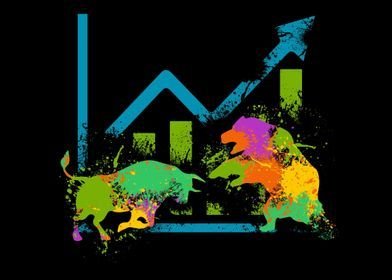Market bubbles are an inherent part of the financial markets, characterized by a rapid escalation in asset prices followed by a contraction.
Recognizing these bubbles and understanding how to avoid the associated pitfalls is crucial for investors aiming to protect their capital and achieve sustainable returns.
This article delves into the mechanics of market bubbles, how to identify them, and strategies for avoiding investment pitfalls.
Understanding Market Bubbles
A market bubble occurs when the price of an asset rises significantly above its intrinsic value, driven by exuberant market behavior and speculative trading.
The bubble is typically followed by a sharp decline in prices, often leading to substantial financial losses for investors.
Characteristics of Market Bubbles
Excessive Speculation: Market bubbles are fueled by excessive speculation where investors buy assets with the expectation of selling them at higher prices rather than based on fundamental value.
Rapid Price Increase: A hallmark of bubbles is the rapid and often unsustainable increase in asset prices. This surge is usually driven by a herd mentality, where investors follow others into the market without conducting due diligence.
Disconnection from Fundamentals: During a bubble, asset prices significantly diverge from their intrinsic values based on fundamental analysis, such as earnings, dividends, or economic indicators.
Widespread Euphoria: Market sentiment during bubbles is characterized by widespread euphoria and irrational exuberance.
News media, analysts, and even everyday investors contribute to the hype, further inflating prices.
Leverage and Debt: Bubbles often involve high levels of leverage, where investors borrow money to invest in the rising market, amplifying both potential gains and losses.
Historical Examples of Market Bubbles
Tulip Mania (1637): One of the earliest recorded bubbles, where the price of tulip bulbs in the Netherlands skyrocketed to unprecedented levels before collapsing.
Dot-com Bubble (1995-2000): A classic example where the stock prices of internet companies soared without corresponding increases in actual profitability, leading to a severe market crash.
Housing Bubble (2000-2008): Driven by speculative buying and excessive mortgage lending, housing prices in many countries rose dramatically before crashing, triggering the global financial crisis.
Identifying Market Bubbles
Recognizing the signs of a market bubble can help investors make informed decisions and avoid significant losses. Here are key indicators to watch for:
1. Rapid and Unjustified Price Increases
One of the most apparent signs of a bubble is a rapid increase in asset prices without a corresponding improvement in underlying fundamentals.
Investors should be wary of assets that have experienced significant price gains in a short period without a clear reason based on earnings growth, technological innovation, or other concrete factors.
2. High Price-to-Earnings (P/E) Ratios
High P/E ratios can indicate that stocks are overvalued relative to their earnings. While a high P/E ratio might be justified in growth stocks, an excessively high ratio across the market suggests inflated prices and potential bubble conditions.
3. Widespread Media Hype
When media coverage becomes overwhelmingly positive and speculative stories dominate the news, it can be a sign that the market is in bubble territory.
Euphoric headlines and predictions of endless growth often accompany bubble phases.
4. Increased Retail Investor Participation
A surge in participation from retail investors, especially those with little investment experience, can signal a bubble.
This often occurs when individuals are drawn to the market by stories of quick riches and rising prices, leading to herd behavior.
5. Excessive Leverage and Borrowing
High levels of margin debt and borrowing to invest can indicate that a bubble is forming.
When investors use borrowed money to buy assets, it inflates prices and increases market risk, as any downturn can lead to forced selling and rapid declines.
6. Disconnect Between Prices and Fundamentals
A clear sign of a bubble is when asset prices deviate significantly from their fundamental values.
For example, if stock prices are rising while corporate earnings are stagnant or declining, it suggests that speculation is driving the market.
Avoiding Investment Pitfalls
Avoiding the pitfalls associated with market bubbles requires a combination of vigilance, discipline, and a sound investment strategy.
Here are some strategies to help investors navigate bubble-prone markets:
1. Conduct Thorough Research
Investors should conduct comprehensive research before making investment decisions.
This involves analyzing a company’s financial statements, understanding its business model, and evaluating its competitive position.
Fundamental analysis helps investors determine the intrinsic value of an asset and identify potential overvaluation.
2. Maintain a Long-Term Perspective
Short-term market fluctuations are often driven by speculation and sentiment. Maintaining a long-term perspective helps investors focus on fundamental value rather than getting caught up in market hype.
Long-term investing also allows for the compounding of returns and reduces the impact of short-term volatility.
3. Diversify Your Portfolio
Diversification involves spreading investments across different asset classes, sectors, and geographic regions to reduce risk.
A diversified portfolio is less likely to suffer significant losses from the collapse of a single asset or market.
By balancing investments, investors can protect themselves from the full impact of a bubble burst.
4. Set Realistic Expectations
Investors should set realistic expectations for returns and be wary of investments that promise unusually high returns.
If an investment sounds too good to be true, it likely is. Setting conservative targets and avoiding the lure of quick profits helps prevent falling into speculative traps.
5. Monitor Market Indicators
Regularly monitoring key market indicators, such as P/E ratios, margin debt levels, and economic indicators, can provide early warning signs of a potential bubble
. Staying informed about market conditions helps investors make timely adjustments to their portfolios.
6. Avoid Herd Mentality
Resisting the urge to follow the crowd is crucial for avoiding bubbles.
Herd mentality often leads investors to buy high and sell low, resulting in significant losses.
Making independent, informed decisions based on thorough analysis helps investors avoid being swept up in market euphoria.
7. Use Stop-Loss Orders
Stop-loss orders can help protect investments from significant declines.
By setting a predetermined price at which to sell an asset, investors can limit their losses in the event of a market downturn.
This strategy helps manage risk and provides a safeguard against the rapid price drops associated with bubble bursts.
8. Stay Disciplined with Asset Allocation
Maintaining a disciplined approach to asset allocation ensures that investments are aligned with an investor’s risk tolerance and financial goals.
Regularly rebalancing the portfolio to maintain the desired asset mix helps manage risk and avoid overexposure to potentially overvalued markets.
9. Consider Alternative Investments
Including alternative investments, such as real estate, commodities, or hedge funds, in a portfolio can provide diversification and reduce reliance on traditional asset classes.
Alternatives often have different risk-return profiles and can perform well in different market conditions.
10. Educate Yourself Continuously
Continuous education is vital for staying ahead of market trends and understanding the evolving financial landscape.
Reading books, attending seminars, and following reputable financial news sources can enhance an investor’s knowledge and ability to identify and avoid bubbles.
Case Studies: Learning from the Past
Analyzing past market bubbles provides valuable lessons and insights into how bubbles form and burst. Here are two notable examples:
Dot-com Bubble (1995-2000)
Formation:
The mid-to-late 1990s saw an explosion in internet-related businesses, leading to massive investment in tech companies.
Investors were captivated by the potential of the internet, leading to speculative investments in any company associated with the web, regardless of its business model or profitability.
Companies went public with inflated valuations, and many had little to no earnings.
Burst:
By 2000, the bubble burst as it became clear that many dot-com companies were not profitable.
The NASDAQ Composite Index, heavily weighted with tech stocks, fell nearly 80% from its peak.
Many investors lost significant sums, and numerous dot-com companies went bankrupt.
Lessons Learned:
Skepticism of Hype: Investors should be skeptical of excessive hype and ensure that investments are based on sound fundamentals.
Importance of Earnings: Companies must have a viable path to profitability, and investors should be wary of businesses with unproven revenue models.
Housing Bubble (2000-2008)
Formation:
The early 2000s saw a dramatic increase in housing prices fueled by easy credit, subprime mortgages, and speculative buying.
Financial institutions bundled and sold mortgage-backed securities, spreading risk throughout the financial system.
Homebuyers and investors assumed that housing prices would continue to rise indefinitely.
Burst:
In 2007, rising default rates on subprime mortgages triggered a decline in housing prices.
The collapse of the housing market led to significant losses for financial institutions and investors, culminating in the global financial crisis.
Major financial institutions failed or required government bailouts, and the global economy entered a severe recession.
Lessons Learned:
Due Diligence: Investors should conduct thorough due diligence on complex financial products and understand the risks involved.
Caution with Leverage: High levels of debt can amplify losses, and excessive leverage is a common factor in market bubbles.
Systemic Risk Awareness: Diversification should consider systemic risks that can affect multiple asset classes simultaneously.
Market bubbles pose significant risks to investors, but with vigilance and a disciplined approach, it is possible to spot them and avoid the associated pitfalls.
By understanding the characteristics of bubbles, monitoring key indicators, and employing sound investment strategies, investors can protect their capital and achieve sustainable long-term returns.
Recognizing rapid and unjustified price increases, high P/E ratios, widespread media hype, increased retail participation, excessive leverage, and a disconnect between prices and fundamentals are crucial for identifying potential bubbles.
Avoiding herd mentality, conducting thorough research, maintaining a long-term perspective, diversifying portfolios, and using stop-loss orders are essential strategies for mitigating risks.
Learning from historical examples such as the dot-com bubble and the housing bubble provides valuable lessons on the importance of skepticism, due diligence, caution with leverage, and awareness of systemic risks.
Continuous education and a disciplined approach to asset allocation further enhance an investor’s ability to navigate bubble-prone markets.
Ultimately, while market bubbles are an inevitable part of investing, a prudent and informed approach can help investors steer clear of the most dangerous pitfalls and achieve their financial goals with confidence.
ALSO READ: Key Indian Stocks Across Various Industries




